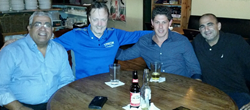Zahari Libi, Michael Lien, Guy Meiri and Oz Ben-Shalom
The advantages of TRIC lie in its compact size, adaptability to a large number of construction sites and the possibility of setting it up in a manhole.
Alameda, CA (PRWEB)
December 10, 2015
On October 12th and 13th, burst pipe manufacturer TRIC Tools hosted Meiri Technologies from Israel. Meiri Technologies is a trenchless technology company based in Tel Aviv, Israel. Meiri was one of the first companies in the Middle East to license Insituform’s CIPP (Cured-in Place Pipe) technology for trenchless repair of underground pipelines. Guy Meiri, Director of Business Development, contacted TRIC three months prior to visiting the TRIC facilities. Guy was assisted by CEO Zaharia Libi and Executive Vice President Oz Ben-Shalom. Meiri Technologies was founded by Guy’s father and is now a subsidiary of Milgam City Services Ltd. based in Tel Aviv, Israel. Milgam City Services was founded in May 1983 as a company providing plumbing and water services to local authorities. Milgam provides comprehensive services to the local community, both managing and operating all sanitary sewer and water systems for the communities. This includes the full maintenance and operation of the municipal water systems.
While Meiri Technologies was in Alameda, they visited two equipment owner construction sites in the Bay Area who were using TRIC equipment. TRIC Field Trainer Jose Moreno took Mr. Libi, Mr. Meiri, and Mr. Ben-Shalom to the Sewer Connection site in El Sobrante, California where TRIC’s X30 burst pipe system replaced a 4-inch, 70-foot sewer line. The following day, they saw Bay Hawk Construction replace a 65-foot-4-inch sewer line with TRIC’s M50 system, powered by a Bobcat in Richmond, CA. The 4-inch line ran through three neighboring courtyards. Both Sewer Connection and Bay Hawk have been using TRIC technology for over 10 years. Bay Hawk’s Ramaldo Perez showed Meiri Technologies the area where they had replaced an 8-inch line in September by placing the M50 in a manhole. The manhole for the 8 “project was just a few feet from the 4” project draw pit. Mr. Libi also discussed with Ramaldo how the mandatory sewer replacement program in the Bay Area is encouraging municipalities to replace the underground infrastructure. In this case, the 4-inch clay pipe was cracked and had been leaking for a number of years.
Meiri’s team was hoping that the M50 burst pipe system would be installed in a manhole or that the M100 would replace a 10-inch pipe while in the US. Since TRIC could not coordinate any of these contract projects, Guy Meiri contacted TRIC users who had either used the M50 in a manhole or worked with the M100 system. Guy spoke with John Galligan of Philadelphia of Pipeshark, Matt Lapinsky, former director of public works in Aberdeen Maryland, and Jim Theriault of Omni Eye of Orlando, FL before finalizing the purchase agreement. Both John Galligan and Jim Theriault discussed various work situations in which they had used the TRIC system. Both have been using TRIC devices for over 10 years and were happy to share their experiences with the M50 and M100 hydraulic extractors. Mr. Galligan said, “The advantages of TRIC are its compact size, adaptability to a wide variety of construction sites, and the ability to position it in a manhole. ”
TRIC invented and patented the first Lateral Pipe Bursting System while also obtaining national approval for HDPE pipes for its use. This opened the market for the trenchless exchange of house sewers in America.
For more information on trenchless pipe rupture equipment, or the trenchless industry in general, call 888-883-8742 or visit the TRIC website at http://www.trictrenchless.com to see how these questions can be answered for you .
Share articles on social media or via email:


Comments are closed.